An Environmental and Nutritional Evaluation of School Food Menus in Bahia, Brazil That Contribute to Local Public Policy to Promote Sustainability
Abstract
:1. Introduction
2. Materials and Methods
2.1. School Food Menus
2.2. Nutritional Content
2.3. Environmental Impact
2.4. Public Engagement Component
2.5. Statistical Analysis
2.6. Ethical Aspects
3. Results
3.1. School Meals
3.2. Nutritional Content and Qualitative Evaluation
3.3. Nutritional Adequacy
3.4. Environmental Impact
3.5. Public Engagement Component
4. Discussion
5. Conclusions
Supplementary Materials
Author Contributions
Funding
Institutional Review Board Statement
Informed Consent Statement
Acknowledgments
Conflicts of Interest
References
- Crippa, M.; Solazzo, E.; Guizzardi, D.; Monforti-Ferrario, F.; Tubiello, F.N.; Leip, A. Food systems are responsible for a third of global anthropogenic GHG emissions. Nat. Food 2021, 2, 198–209. [Google Scholar] [CrossRef]
- Swinburn, B.A.; Kraak, V.I.; Allender, S.; Atkins, V.J.; Baker, P.I.; Bogard, J.R.; Brinsden, H.; Calvillo, A.; De Schutter, O.; Devarajan, R.; et al. The Global Syndemic of Obesity, Undernutrition, and Climate Change: The Lancet Commission report. Lancet 2019, 393, 791–846. [Google Scholar] [CrossRef]
- 2020 Global Nutrition Report: Action on Equity to End Malnutrition; Development Initiatives: Bristol, UK, 2020.
- FAO. The State of Food and Agriculture 2016: Climate Change, Agriculture and Food Security; 9789251093740; Food and Agriculture Organization of the United Nations: Rome, Italy, 2017. [Google Scholar]
- GBD Risk Factors Collaborators. Global, regional, and national comparative risk assessment of 84 behavioural, environmental and occupational, and metabolic risks or clusters of risks, 1990-2016: A systematic analysis for the Global Burden of Disease Study 2016. Lancet 2017, 390, 1345–1422. [Google Scholar] [CrossRef] [Green Version]
- Pérez-Escamilla, R. Food Security and the 2015–2030 Sustainable Development Goals: From Human to Planetary Health: Perspectives and Opinions. Curr. Dev. Nutr. 2017, 1, e000513. [Google Scholar] [CrossRef] [PubMed]
- Springmann, M.; Clark, M.; Mason-D’Croz, D.; Wiebe, K.; Bodirsky, B.L.; Lassaletta, L.; de Vries, W.; Vermeulen, S.J.; Herrero, M.; Carlson, K.M.; et al. Options for keeping the food system within environmental limits. Nature 2018, 562, 519–525. [Google Scholar] [CrossRef] [PubMed]
- Batlle-Bayer, L.; Bala, A.; Aldaco, R.; Vidal-Mones, B.; Colome, R.; Fullana, I.P.P. An explorative assessment of environmental and nutritional benefits of introducing low-carbon meals to Barcelona schools. Sci. Total Environ. 2021, 756, 143879. [Google Scholar] [CrossRef] [PubMed]
- Sidaner, E.; Balaban, D.; Burlandy, L. The Brazilian school feeding programme: An example of an integrated programme in support of food and nutrition security. Public. Health Nutr. 2013, 16, 989–994. [Google Scholar] [CrossRef] [PubMed] [Green Version]
- Kitaoka, K. The National School Meal Program in Brazil: A Literature Review. Jpn. J. Nutr. Diet. 2018, 76, S115–S125. [Google Scholar] [CrossRef] [Green Version]
- Brasil. Portal Brasileiro de Dados Abertos. Alunos Atendidos pelo PNAE. Available online: https://dados.gov.br/dataset/alunos-atendidos-pelo-pnae-2014 (accessed on 13 January 2022).
- IBGE. Pesquisa de Orçamentos Familiares 2008-2009: Tabela de Composição Nutricional dos Alimentos Consumidos no Brasil, 1st ed.; IBGE: Rio de Janeiro, Brazil, 2011. [Google Scholar]
- Philippi, S.T. Tabela de Composição de Alimentos: Suporte Para Decisão Nutricional; Manole: Barueri, Brazil, 2012; p. 161. [Google Scholar]
- Brasil. RESOLUÇÃO Nº 26, DE 17 DE JUNHO DE 2013. Dispõe sobre o Atendimento da Alimentação Escolar aos Alunos da Educação Básica no Âmbito do Programa Nacional de Alimentação Escolar. 2013. Available online: https://www.fnde.gov.br/acesso-a-informacao/institucional/legislacao/item/4620-resolu%C3%A7%C3%A3o-cd-fnde-n%C2%BA-26,-de-17-de-junho-de-2013 (accessed on 29 March 2022).
- Dietary Reference Intakes for Thiamin, Riboflavin, Niacin, Vitamin B6, Folate, Vitamin B12, Pantothenic Acid, Biotin, and Choline; Reports funded by National Institutes of Health; The National Academies Collection: Washington, DC, USA, 1998.
- Dietary Reference Intakes for Energy, Carbohydrate, Fiber, Fat, Fatty Acids, Cholesterol, Protein, and Amino Acids; National Academy Press: Washington, DC, USA, 2005.
- Monteiro, C.A.; Cannon, G.; Levy, R.B.; Moubarac, J.C.; Louzada, M.L.; Rauber, F.; Khandpur, N.; Cediel, G.; Neri, D.; Martinez-Steele, E.; et al. Ultra-processed foods: What they are and how to identify them. Public Health Nutr. 2019, 22, 936–941. [Google Scholar] [CrossRef]
- Garzillo, J.M.F.; Machado, P.P.; Louzada, M.L.d.C.; Levy, R.B.; Monteiro, C.A. Footprints of Foods and Culinary Preparations Consumed in Brazil; Faculdade de Saúde Pública da USP: São Paulo, Brazil, 2020. [Google Scholar]
- Poore, J.; Nemecek, T. Reducing food’s environmental impacts through producers and consumers. Science 2018, 360, 987–992. [Google Scholar] [CrossRef] [Green Version]
- R Core Team. R: A Language and Environment for Statistical Computing, Vienna. 2021. Available online: http://r.meteo.uni.wroc.pl/web/packages/dplR/vignettes/intro-dplR.pdf (accessed on 29 March 2022).
- Sustainable Diets and Biodiversity: Directions and Solutions for Policy, Research and Action; FAO: Rome, Italy, 2012.
- Steffen, W.; Richardson, K.; Rockstrom, J.; Cornell, S.E.; Fetzer, I.; Bennett, E.M.; Biggs, R.; Carpenter, S.R.; de Vries, W.; de Wit, C.A.; et al. Sustainability. Planetary boundaries: Guiding human development on a changing planet. Science 2015, 347, 1259855. [Google Scholar] [CrossRef] [PubMed] [Green Version]
- FAO. Water for Sustainable Food and Agriculture: A report produced for the G20 Presidency of Germany; FAO: Rome, Italy, 2017. [Google Scholar]
- Schuck, C.; Ribeiro, R. Comendo o Planeta: Impactos Ambientais da Criação e Consumo de Animais; Sociedade Vegetariana Brasileira: São Paulo, Brazil, 2015. [Google Scholar]
- Willett, W.; Rockstrom, J.; Loken, B.; Springmann, M.; Lang, T.; Vermeulen, S.; Garnett, T.; Tilman, D.; DeClerck, F.; Wood, A.; et al. Food in the Anthropocene: The EAT-Lancet Commission on healthy diets from sustainable food systems. Lancet 2019, 393, 447–492. [Google Scholar] [CrossRef]
- IBGE. Pesquisa de Orçamentos Familiares 2017–2018: Análise do Consumo Alimentar Pessoal no Brasil; IBGE: Rio de Janeiro, Brazil, 2020. [Google Scholar]
- Bloch, K.V.; Klein, C.H.; Szklo, M.; Kuschnir, M.C.; Abreu Gde, A.; Barufaldi, L.A.; da Veiga, G.V.; Schaan, B.; da Silva, T.L.; de Vasconcellos, M.T.; et al. ERICA: Prevalences of hypertension and obesity in Brazilian adolescents. Rev. Saude Publica 2016, 50 (Suppl. S1), 9. [Google Scholar] [CrossRef] [PubMed]
- WHO. Report of the Commission on Ending Childhood Obesity. Implementation Plan: Executive Summary; World Health Organization: Geneva, Switzerland, 2017. [Google Scholar]
- Elizabeth, L.; Machado, P.; Zinocker, M.; Baker, P.; Lawrence, M. Ultra-Processed Foods and Health Outcomes: A Narrative Review. Nutrients 2020, 12, 1955. [Google Scholar] [CrossRef] [PubMed]
- Lane, M.M.; Davis, J.A.; Beattie, S.; Gomez-Donoso, C.; Loughman, A.; O’Neil, A.; Jacka, F.; Berk, M.; Page, R.; Marx, W.; et al. Ultraprocessed food and chronic noncommunicable diseases: A systematic review and meta-analysis of 43 observational studies. Obes. Rev. 2021, 22, e13146. [Google Scholar] [CrossRef] [PubMed]
- Red Meat and Processed Meat/IARC Working Group on the Evaluation of Carcinogenic Risks to Humans; International Agency for Research on Cancer: Lyon, France, 2018; Volume 114, ISBN 978-92-832-0180-9. ISSN 1017-1606.
- Bouvard, V.; Loomis, D.; Guyton, K.Z.; Grosse, Y.; Ghissassi, F.E.; Benbrahim-Tallaa, L.; Guha, N.; Mattock, H.; Straif, K. Carcinogenicity of consumption of red and processed meat. Lancet Oncol. 2015, 16, 1599–1600. [Google Scholar] [CrossRef] [Green Version]
- Rossi, L.; Ferrari, M.; Martone, D.; Benvenuti, L.; De Santis, A. The Promotions of Sustainable Lunch Meals in School Feeding Programs: The Case of Italy. Nutrients 2021, 13, 1571. [Google Scholar] [CrossRef] [PubMed]
- Ribal, J.; Fenollosa, M.L.; García-Segovia, P.; Clemente, G.; Escobar, N.; Sanjuán, N. Designing healthy, climate friendly and affordable school lunches. Int. J. Life Cycle Assess. 2015, 21, 631–645. [Google Scholar] [CrossRef]
- Eustachio Colombo, P.; Patterson, E.; Lindroos, A.K.; Parlesak, A.; Elinder, L.S. Sustainable and acceptable school meals through optimization analysis: An intervention study. Nutr. J. 2020, 19, 61. [Google Scholar] [CrossRef] [PubMed]
- Craig, W.J.; Mangels, A.R.; American Dietetic, A. Position of the American Dietetic Association: Vegetarian diets. J. Am. Diet. Assoc. 2009, 109, 1266–1282. [Google Scholar] [CrossRef] [PubMed]
- Oussalah, A.; Levy, J.; Berthezene, C.; Alpers, D.H.; Gueant, J.L. Health outcomes associated with vegetarian diets: An umbrella review of systematic reviews and meta-analyses. Clin. Nutr. 2020, 39, 3283–3307. [Google Scholar] [CrossRef] [PubMed]
- BRAZIL. Guia Alimentar para a População Brasileira, 2nd ed.; Ministério da Saúde: Brasilia, Brazil, 2014. [Google Scholar]
- Vale, D.; Lyra, C.O.; Santos, T.T.D.; Souza, C.V.S.; Roncalli, A.G. Acceptance of school food by Brazilian adolescents: Individual and school context determinants. Cien. Saude Colet. 2021, 26, 637–650. [Google Scholar] [CrossRef] [PubMed]
- Boklis-Berer, M.; Rauber, F.; Azeredo, C.M.; Levy, R.B.; Louzada, M. The adherence to school meals is associated with a lower occurrence of obesity among Brazilian adolescents. Prev. Med. 2021, 150, 106709. [Google Scholar] [CrossRef] [PubMed]
- Honório, O.S.; Rocha, L.L.; Fortes, M.I.C.M.; Carmo, A.S.D.; Cunha, C.D.F.; Oliveira, T.R.P.R.D.; Mendes, L.L. Consumption of school meals provided by PNAE among brazilian public school adolescents. Rev. Chil. Nutr. 2020, 47, 765–771. [Google Scholar] [CrossRef]
- Cesar, J.T.; Taconeli, C.A.; Osorio, M.M.; Schmidt, S.T. Adherence to school food and associated factors among adolescents in public schools in the Southern region of Brazil. Cien. Saude Colet. 2020, 25, 977–988. [Google Scholar] [CrossRef] [PubMed]
- Brasil. Resolução CD/FNDE nº 6, de 8 de maio de 2020. Dispõe sobre o atendimento da alimentação escolar aos alunos da educação básica no âmbito do Programa Nacional de Alimentação Escolar. 2020. Available online: https://www.in.gov.br/en/web/dou/-/resolucao-n-6-de-8-de-maio-de-2020-256309972 (accessed on 29 March 2022).
- Costa Leite, J.; Caldeira, S.; Watzl, B.; Wollgast, J. Healthy low nitrogen footprint diets. Glob. Food Sec. 2020, 24, 100342. [Google Scholar] [CrossRef] [PubMed]
- Whitmee, S.; Haines, A.; Beyrer, C.; Boltz, F.; Capon, A.G.; de Souza Dias, B.F.; Ezeh, A.; Frumkin, H.; Gong, P.; Head, P.; et al. Safeguarding human health in the Anthropocene epoch: Report of The Rockefeller Foundation–Lancet Commission on planetary health. Lancet 2015, 386, 1973–2028. [Google Scholar] [CrossRef]
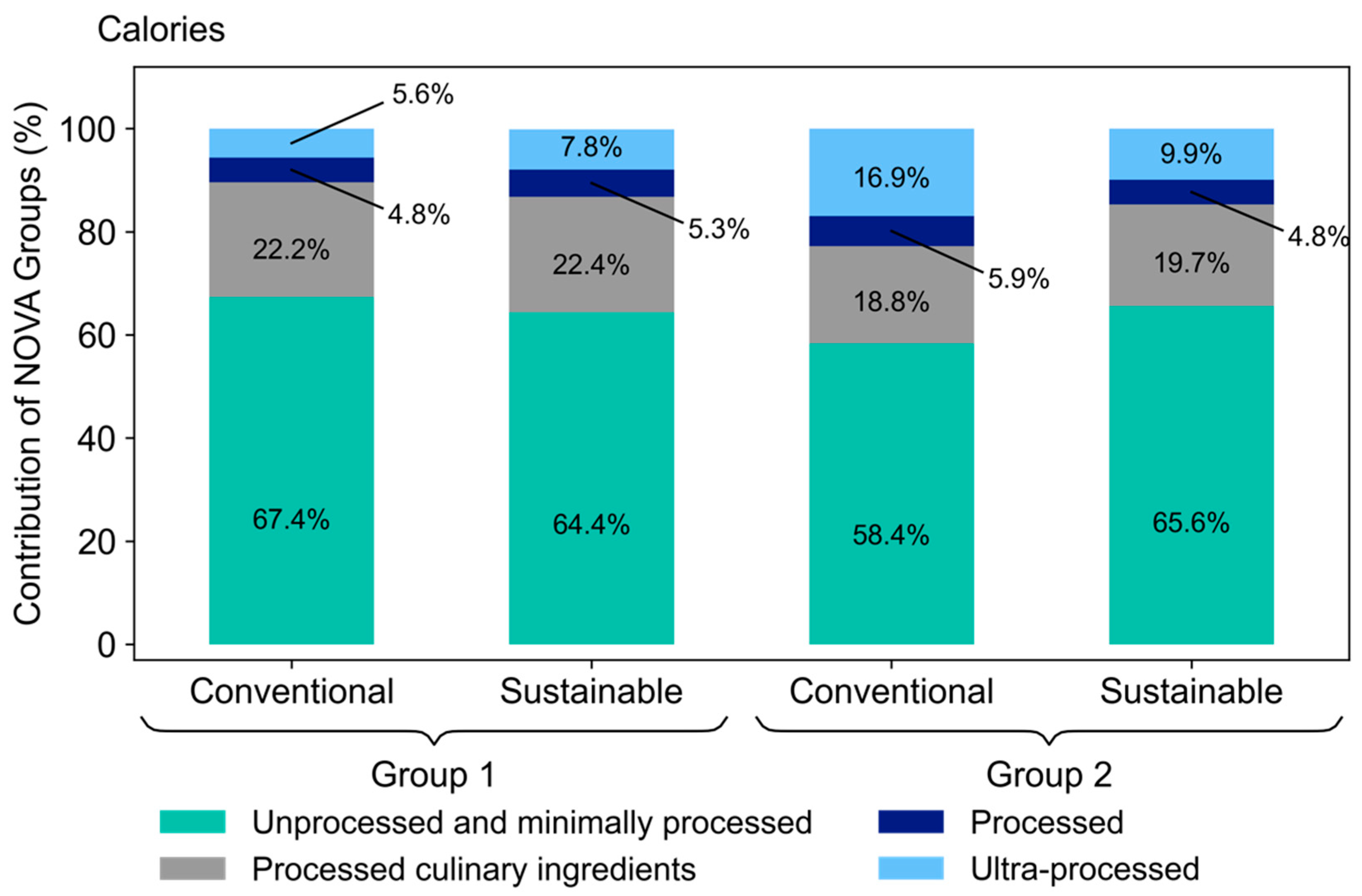
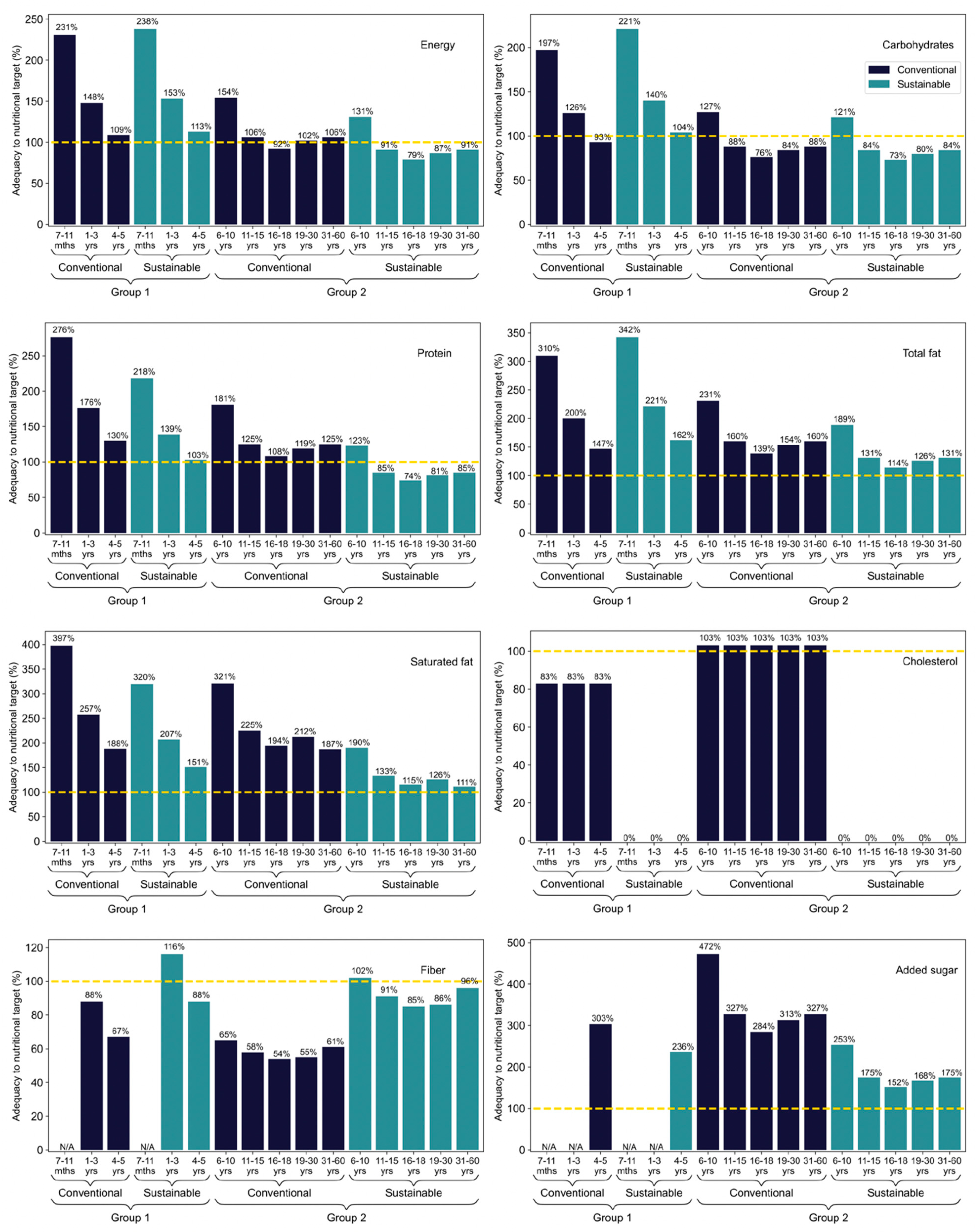
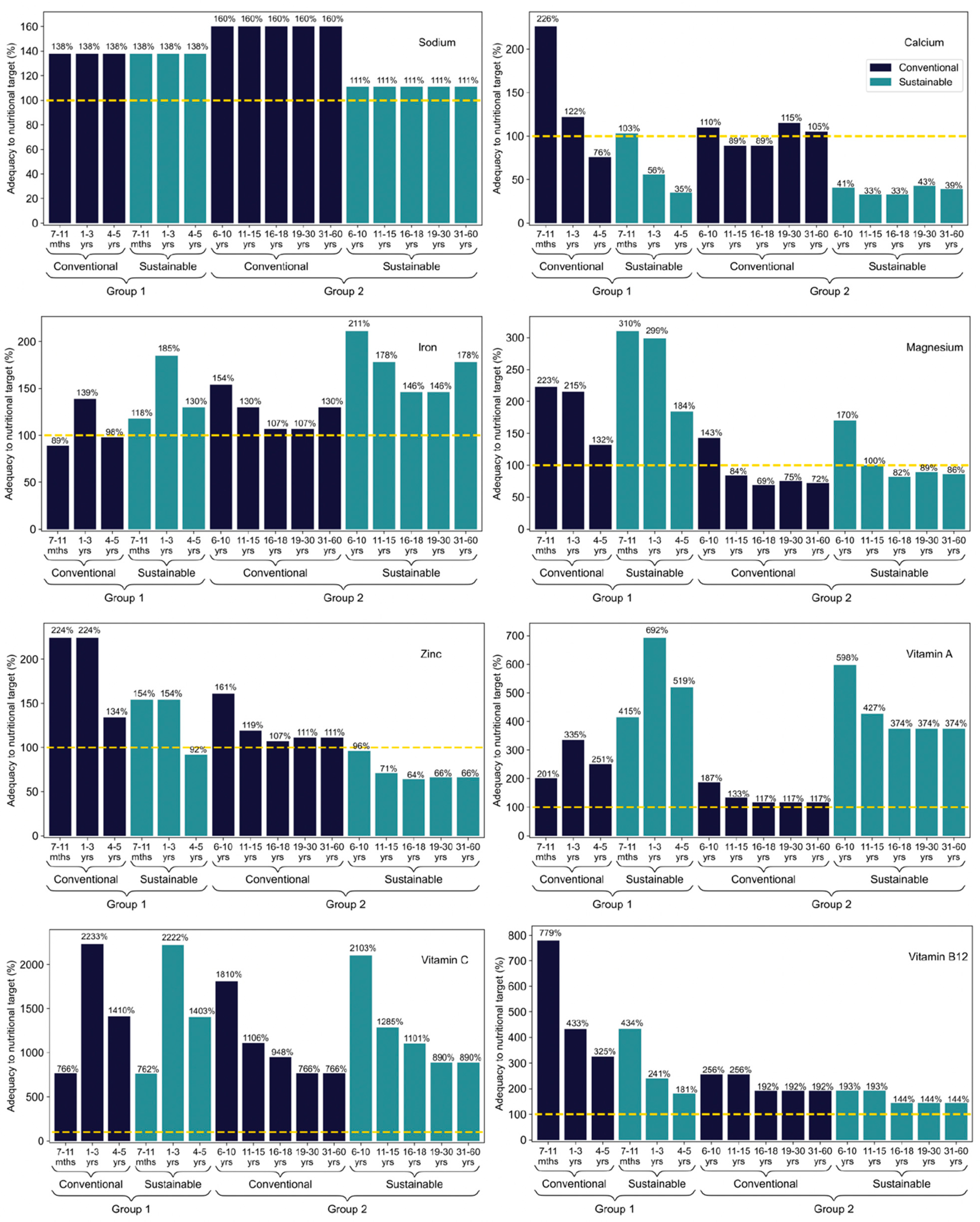
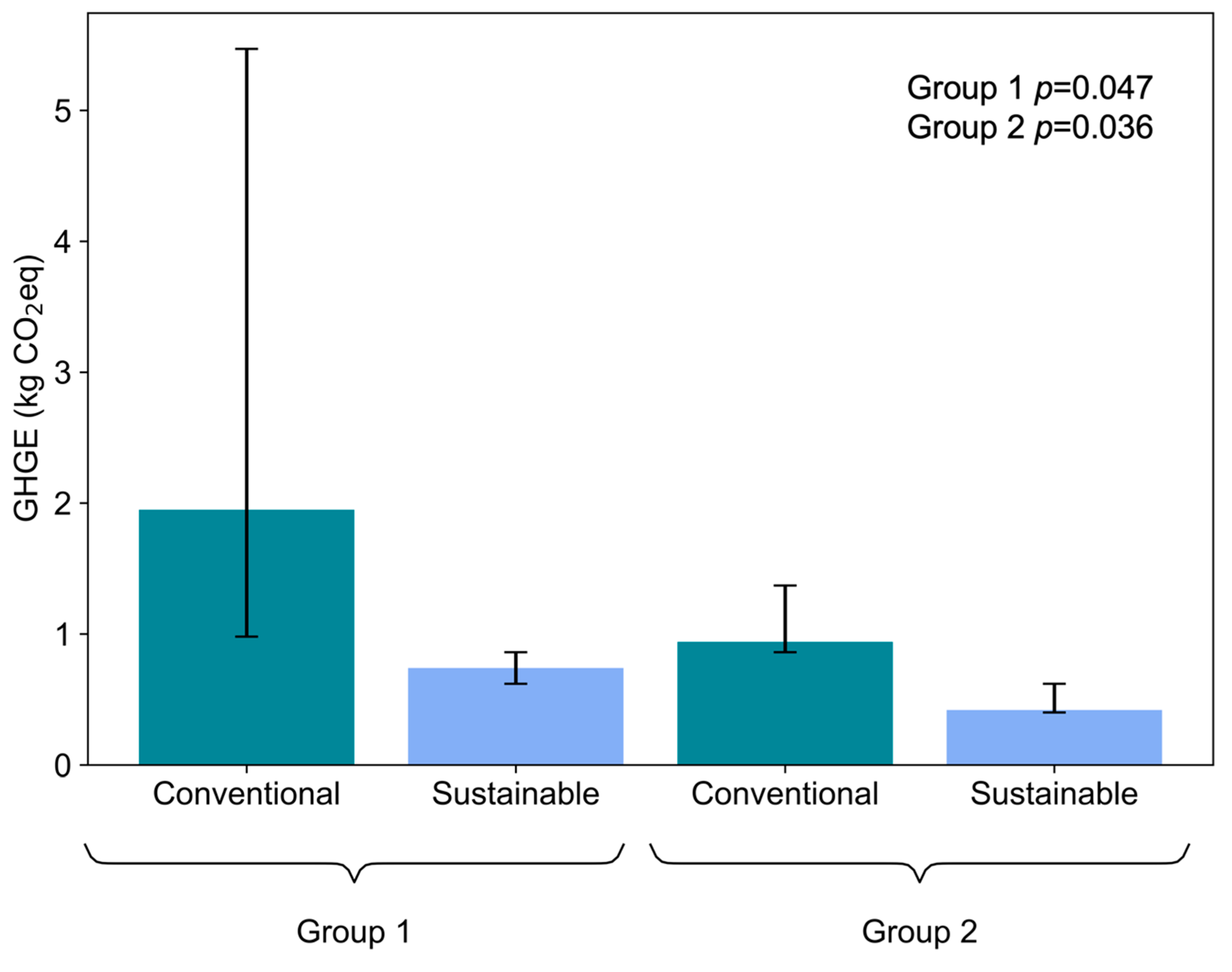
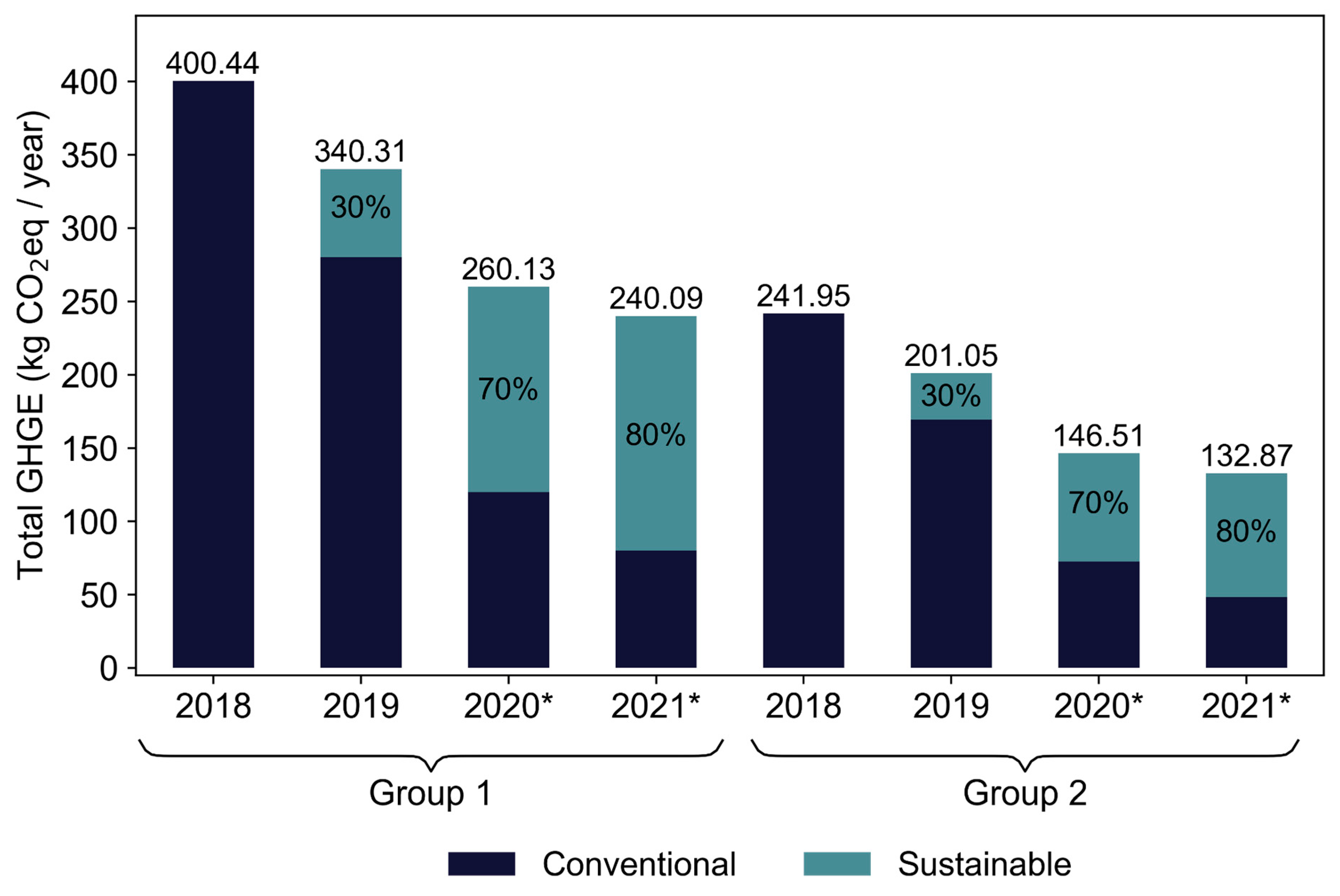
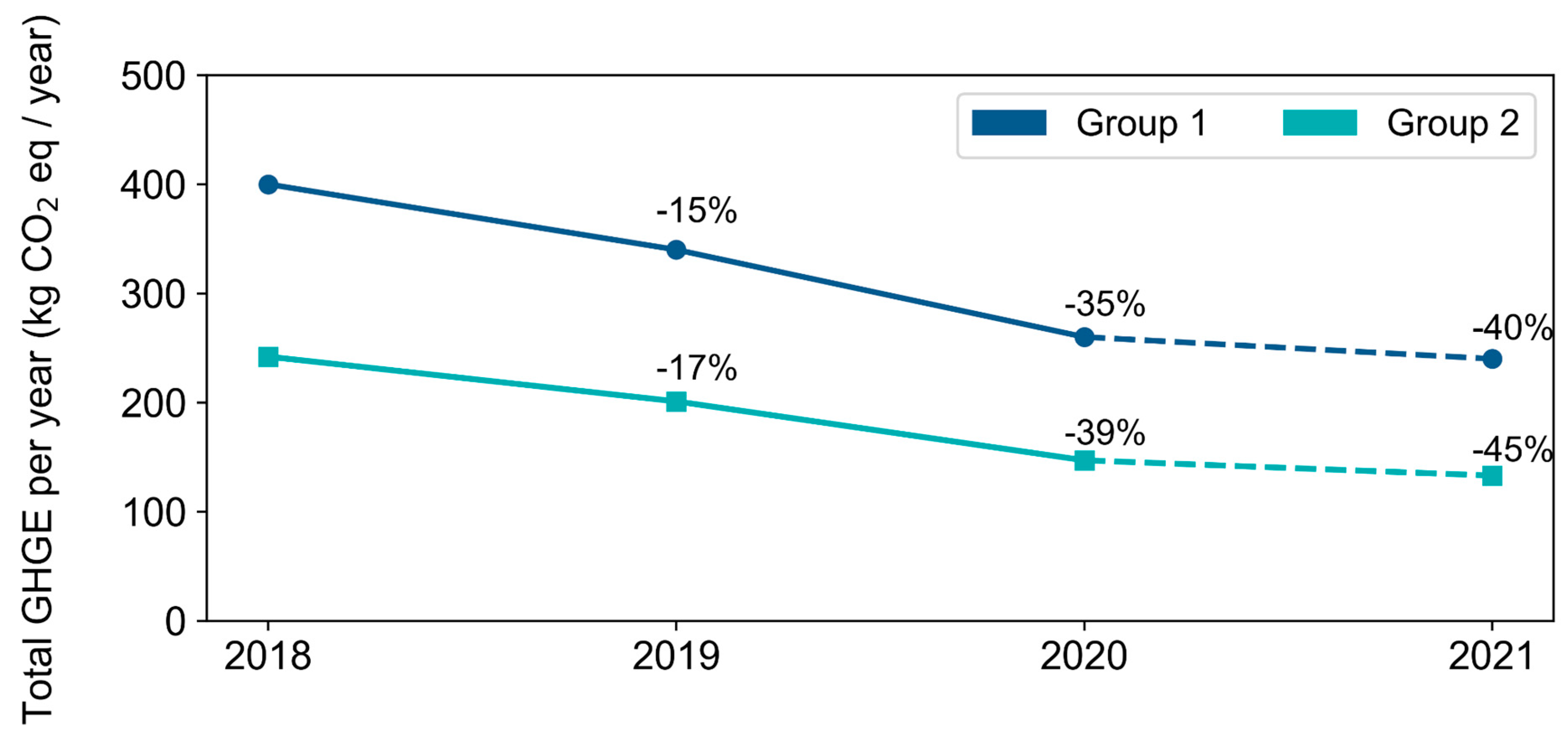
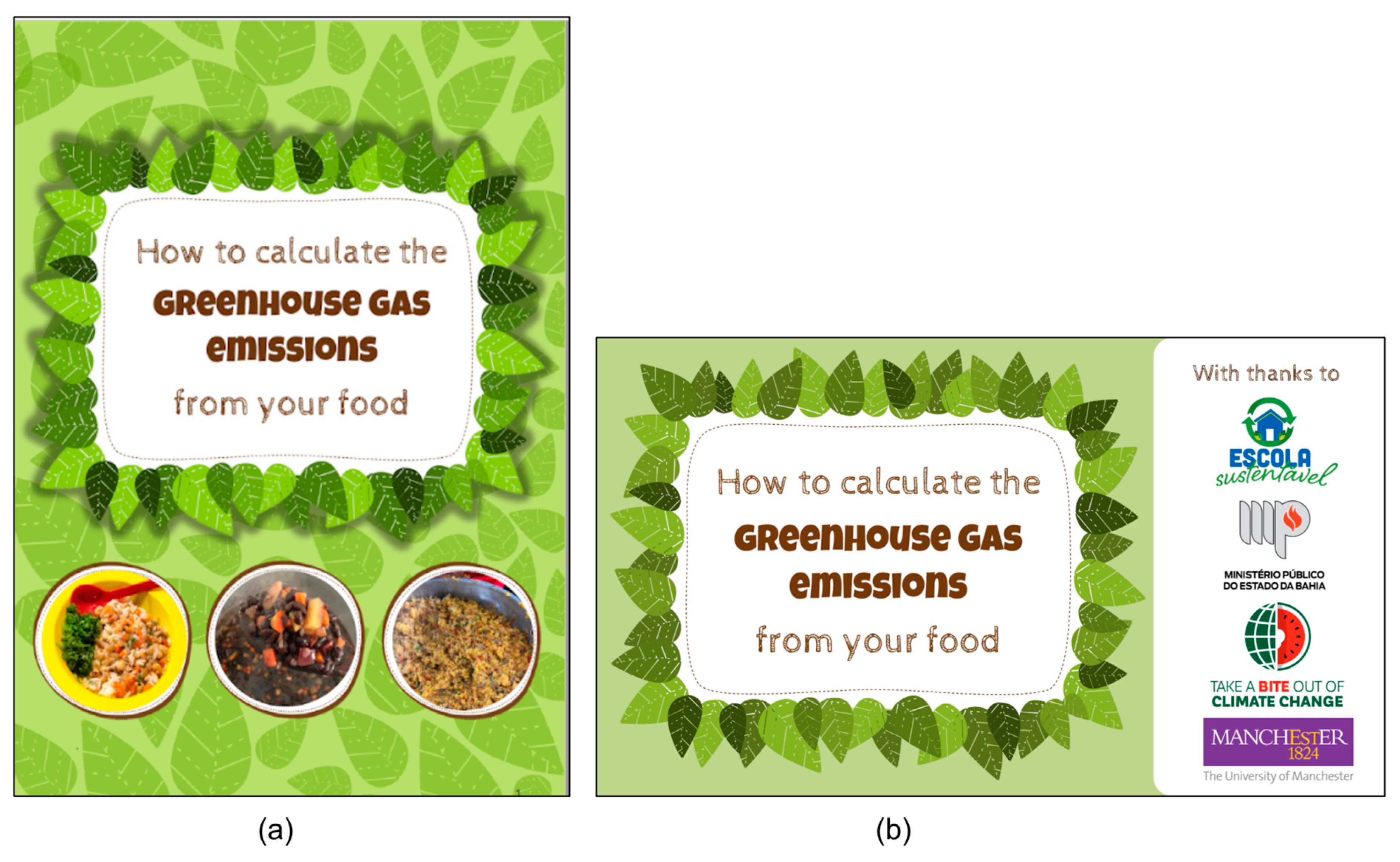
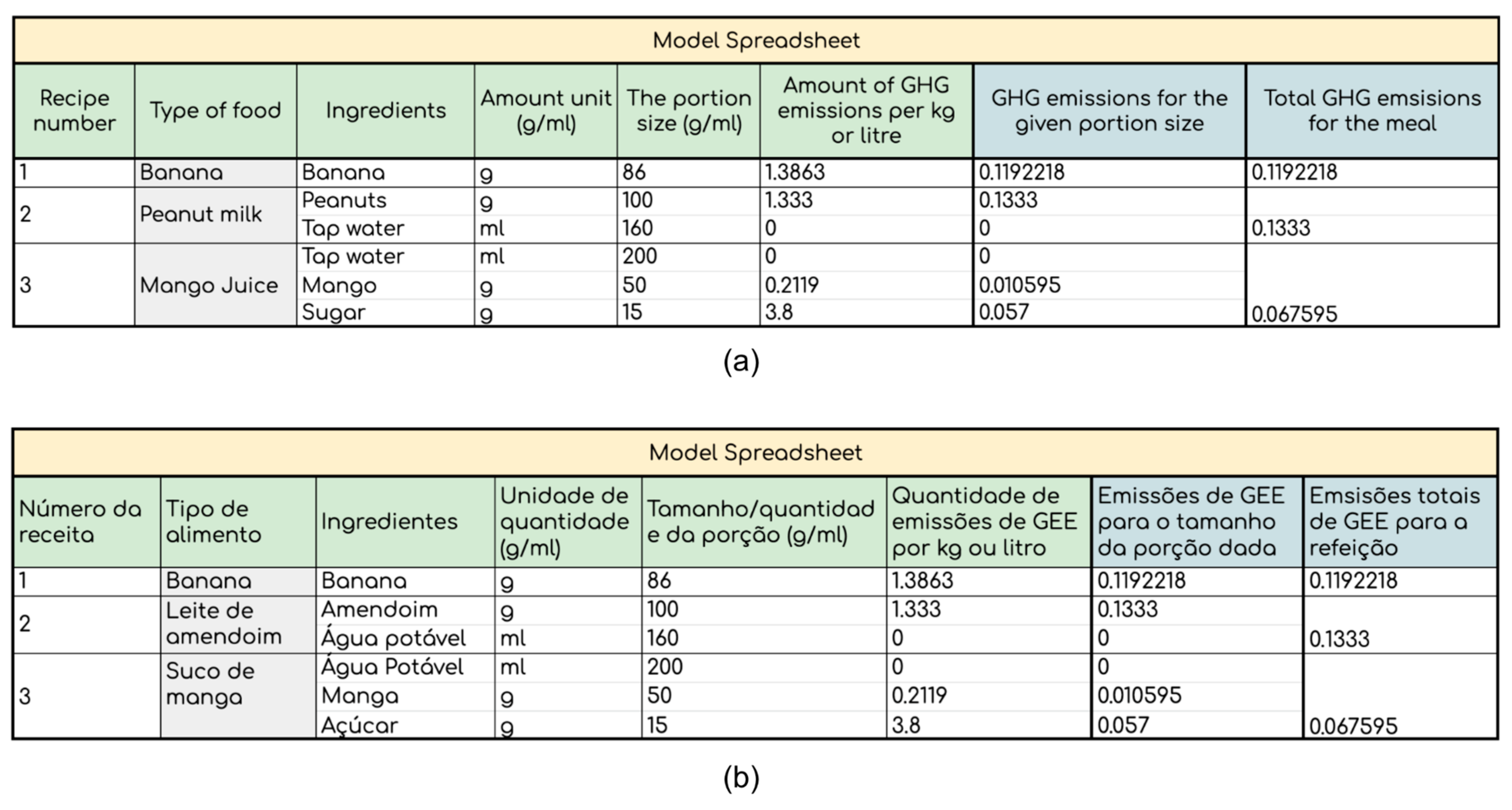
| Day of the Week | Conventional | Sustainable |
|---|---|---|
| Group 1 | ||
| Monday | Meal 1: Latte + Sweet potato Meal 2: Lettuce and tomato salad + Pasta with sardine sauce + Carrot Meal 3: Mango juice + Carrot cake + Banana | Meal 1: Peanut milk + Cassava Meal 2: Beans + Pasta with soya mince + Potato with carrot + Guava juice Meal 3: Mango juice + Bread with peanut butter + Banana |
| Tuesday | Meal 1: Oatmal porridge + Papaya Meal 2: Rice + Beans + Chicken + Mashed potatoes + Guava Meal 3: Flavoured whole milk yogurt + Bread with margarine | Meal 1: Acerola juice + Sweet corn coconut pudding Meal 2: Lettuce salad + Rice + Beans + Okra and pumpkin soya chunks casserole Meal 3: Vegetable soup with soya mince |
| Wednesday | Meal 1: Acerola juice + Cassava with pulled beef Meal 2: Rice + Beans + Fish fillet with potato + Mango Meal 3: Latte + Sweet potato with egg + Papaya | Meal 1: Vegetable soup with soya mince + Finger rolls Meal 2: Rice + Couscous with vegetables and soya mince + Guava juice Meal 3: Papaya and apple smoothie + Cream cracker |
| Thursday | Meal 1: Latte + Couscous Meal 2: Rice + Beans + Minced beef with potato and carrot + Watermelon Meal 3: Guava juice + Coconut cookies | Meal 1: Banana and apple smoothie + Soya mince sandwich Meal 2: Rice + Black beans and vegetables casserole Meal 3: Plant-based Shepherd’s pie + Apple |
| Friday | Meal 1: Banana and apple smoothie Meal 2: Lettuce salad + Muleteer Beans with jerked beef + Braised kale Meal 3: Omelet + Apple | Meal 1: Banana and papaya smoothie + Coconut cake Meal 2: Lettuce and tomato salad + Rice and black-eyed beans with soya mince, carrot, pumpkin and kale Meal 3: Mango juice + Vegetable couscous |
| Group 2 | ||
| Monday | Meal 1: Vegetable and chicken soup + Banana Meal 2: Latte + Couscous with pepperoni | Meal 1: Beans and vegetable soup Meal 2: Vegetable couscous + Banana |
| Tuesday | Meal 1: Mashed potato + Beef bolognese pasta + Watermelon Meal 2: Hot chocolate + Cream cracker | Meal 1: Rice + Vegetables and soya chunks casserole Meal 2: Soya mince sandwich + Watermelon |
| Wednesday | Meal 1: Acerola juice + Cream cracker with guava jam + Papaya Meal 2: Latte + Sweet corn pudding | Meal 1: Acerola juice + Cream cracker with peanut butter Meal 2: Cornmeal porridge + Papaya |
| Thursday | Meal 1: Sweet rice pudding Meal 2: Pasta with tomato sauce + Diced chicken breast | Meal 1: Sweet rice pudding Meal 2: Mango juice + Soya mince + Bolognese pasta |
| Friday | Meal 1: Muleteer beans with jerked beef + Braised kale Meal 2: Latte + Bread with fried egg + Apple | Meal 1: Black beans and vegetables casserole + Cassava flour Meal 2: Guava juice + Coconut cake + Apple |
| Nutrient | Group 1 | Group 2 | ||||
|---|---|---|---|---|---|---|
| Conventional | Sustainable | p Value | Conventional | Sustainable | p Value | |
| Energy, kcal | 1115.65 [897.49; 1171.88] | 1146.15 [986.72; 1184.79] | 0.754 | 713.47 [625.4; 748.58] | 587.11 [524.64; 644.34] | 0.117 |
| Carbohydrates, g/1000 kcal | 146.87 [123.85; 157.35] | 144.94 [143.33; 161.72] | 0.754 | 135.12 [115.16; 140.47] | 151 [140.52; 175.65] | 0.175 |
| Protein, g/1000 kcal | 32.55 [28.49; 42.14] | 29.37 [26.16; 30.04] | 0.175 | 37.02 [34.74; 43.11] | 29.76 [29.06; 34.07] | 0.117 |
| Total fat, g/1000 kcal | 29.46 [28.51; 39.72] | 38.54 [32.17; 38.85] | 0.465 | 37.58 [31.24; 45.63] | 30.99 [30; 38.03] | 0.602 |
| Saturated fat, g/1000 kcal | 12.6 [10.87; 16.44] | 11.58 [8.87; 12.56] | 0.347 | 11.74 [10.99; 15.46] | 13.13 [8.38; 14.19] | 0.602 |
| Cholesterol, mg/1000 kcal | 110.71 [102.64; 284.07] | 0 [0; 0] | 0.005 | 92.53 [76.17; 107.92] | 0 [0; 0] | 0.007 |
| Fiber, g/1000 kcal | 11.28 [8.99; 13.2] | 15.26 [13.61; 16.28] | 0.076 | 8.47 [3.69; 10.22] | 10.81 [10.15; 21.67] | 0.175 |
| Added sugar, g/1000 kcal | 25.6 [22.28; 40.34] | 34.9 [29.54; 36.79] | 0.754 | 23.98 [20.04; 24.92] | 36.16 [0; 41.43] | 0.916 |
| Sodium, mg/1000 kcal | 1908.22 [1612.69; 1912.33] | 1830.43 [1723.08; 2087.48] | 0.917 | 1930.95 [1764.69; 2037.05] | 1069.16 [1065.83; 2002.03] | 0.602 |
| Calcium, mg/1000 kcal | 342.92 [311.32; 478.6] | 182.04 [180.87; 191.27] | 0.009 | 461.94 [437.42; 533.8] | 192.68 [171.79; 314.31] | 0.009 |
| Iron, mg/1000 kcal | 6.24 [6.22; 6.85] | 8.46 [7.74; 9.09] | 0.047 | 7.31 [3.65; 8.31] | 7.82 [7.37; 11.38] | 0.295 |
| Magnesium, mg/1000 kcal | 111.32 [104.89; 126.39] | 162.15 [152.4; 184.71] | 0.076 | 112.48 [112.09; 126.22] | 142.12 [130.45; 172.09] | 0.047 |
| Zinc, mg/1000 kcal | 4.47 [4.2; 5.06] | 2.71 [2.59; 3.16] | 0.175 | 5.17 [3.18; 5.66] | 2.04 [1.96; 2.27] | 0.117 |
| Vitamin A, mcg/1000 kcal | 580.36 [560.69; 667.56] | 1338.17 [1291.71; 1584.11] | 0.076 | 214.14 [213.86; 272.96] | 1841.13 [1188.3; 2167.75] | 0.175 |
| Vitamin C, mg/1000 kcal | 118.61 [59.71; 180.11] | 113.51 [95.84; 140.21] | 0.754 | 45.91 [43.01; 74.5] | 197.91 [84.23; 239.22] | 0.347 |
| Vitamin B12, mcg/1000 kcal | 2.15 [1.58; 3.3] | 1.15 [1.08; 1.53] | 0.076 | 1.94 [1.6; 1.98] | 1.63 [0.81; 2.98] | 0.917 |
Publisher’s Note: MDPI stays neutral with regard to jurisdictional claims in published maps and institutional affiliations. |
© 2022 by the authors. Licensee MDPI, Basel, Switzerland. This article is an open access article distributed under the terms and conditions of the Creative Commons Attribution (CC BY) license (https://creativecommons.org/licenses/by/4.0/).
Share and Cite
Kluczkovski, A.; Menezes, C.A.; da Silva, J.T.; Bastos, L.; Lait, R.; Cook, J.; Cruz, B.; Cerqueira, B.; Lago, R.M.R.S.; Gomes, A.N.; et al. An Environmental and Nutritional Evaluation of School Food Menus in Bahia, Brazil That Contribute to Local Public Policy to Promote Sustainability. Nutrients 2022, 14, 1519. https://doi.org/10.3390/nu14071519
Kluczkovski A, Menezes CA, da Silva JT, Bastos L, Lait R, Cook J, Cruz B, Cerqueira B, Lago RMRS, Gomes AN, et al. An Environmental and Nutritional Evaluation of School Food Menus in Bahia, Brazil That Contribute to Local Public Policy to Promote Sustainability. Nutrients. 2022; 14(7):1519. https://doi.org/10.3390/nu14071519
Chicago/Turabian StyleKluczkovski, Alana, Camilla A. Menezes, Jacqueline Tereza da Silva, Leticia Bastos, Rebecca Lait, Joanne Cook, Bruno Cruz, Bruna Cerqueira, Renata M. R. S. Lago, Alexvon N. Gomes, and et al. 2022. "An Environmental and Nutritional Evaluation of School Food Menus in Bahia, Brazil That Contribute to Local Public Policy to Promote Sustainability" Nutrients 14, no. 7: 1519. https://doi.org/10.3390/nu14071519
APA StyleKluczkovski, A., Menezes, C. A., da Silva, J. T., Bastos, L., Lait, R., Cook, J., Cruz, B., Cerqueira, B., Lago, R. M. R. S., Gomes, A. N., Ladeia, A. M. T., Schmidt Rivera, X., Vianna, N., Reynolds, C. J., Oliveira, R. R., & Bridle, S. L. (2022). An Environmental and Nutritional Evaluation of School Food Menus in Bahia, Brazil That Contribute to Local Public Policy to Promote Sustainability. Nutrients, 14(7), 1519. https://doi.org/10.3390/nu14071519









